|
Introduction |
|
 |
|
Read about the elements and principles of art before
viewing the Introduction.
Elements
of Art |
Principles
of Art
|
Definitions
|
Guide
Download Printable
Summary
|
|
BRANCHES OF EDUCATION |
|
HUMANITIES
-
Performing Arts
-
Visual
Arts
-
Architecture
-
Literature
-
History
-
Philosophy
-
Religion
-
Languages
and Linguistics
-
Jurisprudence (theory and philosophy of
law)
LIBERAL ARTS
Liberal arts subjects are not
related to the professional, vocational, or
technical curriculum.
-
Humanities
-
Mathematics
-
Social Sciences
-
Physical Sciences
SOCIAL
SCIENCE
-
Sociology
-
Anthropology
-
Archaeology
-
Cultural
and Ethnic Studies
-
Economics
-
Gender
and Sexuality
-
Geography
-
Political
Science
-
Psychology
NATURAL
SCIENCE
-
Physics
-
Chemistry
-
Space
Sciences
-
Earth
Sciences
-
Life
Sciences
FORMAL
SCIENCES
-
Computer
Sciences
-
Logic
(also a branch of philosophy)
-
Mathematics
-
Statistics
PROFESSIONS & APPLIED SCIENCES
-
Design
-
Engineering
-
Education
-
Business
-
Forestry
and
Environmental Studies
-
Family
and Consumer Science
-
Health
Sciences
-
Journalism, Media, and Communications
-
Law
(jurisprudence is a humanities)
-
Library
and Museum Studies
-
Military
Sciences
-
Public
Administration
-
Social
Work
-
Transportation
-
Agriculture
|
Although we separate the
humanities from the sciences and math, it wasn't always that
way. Medieval scholars classified the humanities as studies
that are relevant to humans. The humanities included:
philosophy (the sciences were called natural philosophy),
math, and the arts. Theology and religion were rendered onto
God. We now consider Theology to be part of
philosophy while religion is not included in philosophy, but both are included in
the humanities.
Did you know that PhD stands for Doctor of Philosophy.
The branches of philosophy include:
- Aesthetics
is the study of art and beauty. Some examples of aesthetic
questions are: what is beauty, and what is beauty doing
here?

Is beauty an average?
read more
Sir Francis Galton, English (1822 – 1911)
He was a polymath: statistician, sociologist, psychologist,
anthropologist, eugenicist, tropical explorer, geographer,
inventor, meteorologist, and proto-geneticist.
Galton devised a technique called composite
portraiture. He superimposed multiple photographs of
individual faces, created an average face for men and women.
- Metaphysics is the study of the basic nature of reality.
Traditional branches are cosmology and ontology. Cosmology
is the study of the universe. Ontology is the general study
of reality, types of being, what can be said to exist, and
how they should be categorized.
- Epistemology is the study of the nature and scope of
knowledge. Skepticism is the belief that knowledge is
impossible.
- Ethics is moral theory. The main branches are applied
ethics, meta-ethics, and normative ethics. Meta-ethics asks
whether absolute moral truths exist, and how we can know
them. Normative ethics asks what act, or personality traits,
are good or bad.
- Political philosophy is the study of government. It
includes justice, law, and property.
- Logic is the study of proper reasoning.
- Philosophy of mind deals with theory of mind. One of it's
main concerns is the mind body problem.
- Philosophy of language
- Theology is theory of God.
Conventions:




photos by john chiappone
|
The
Chrysler Crossfire concept car
has a great sense of repetition. The production car
was built for Chrysler by Karmann of Germany - with
parts from Mercedes Benz.
For legal reasons, Chrysler was forced to change one thing;
what
do you think they changed?
With this car, do you think form follow function, or
does function follow form? |
Painting Methods
We start by stretching raw canvas on a wooden frame.
When you stretch a canvas, you put one staple in the
center on the top, and one in the center on the bottom. Next put
on staple in the center of each side. We then go back to the
top, and put 2 or 3 staples to the right of the center staple.
Do the same to the right side, and keep moving clockwise until the canvas is completely stretched.
After the canvas is
stretched, we paint it with gesso - a flat white primer.
This prevents the paint from sinking into the canvass, and makes
it easier to fix the painting in the future.
Images are sketched with a brush
because pencils crack the gesso, and years later those cracks
appear through the surface. This is why you never write on the
back of a painting.
The first layer of paint is thin,
sketchy, and spontaneous. We call this the underpainting. Some are monochromatic.
Painting with shades of only one color is called Grisaille.
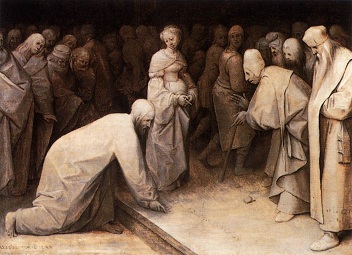
Christ and the Woman Taken in Adultery by Pieter Bruegel the
Elder
We
build thicker layers on top of thinner layers. We don't put
thinner layers on top of thicker layers because that also
promotes cracking. The paint needs to dry enough before a new
layer can be applied. When the final layer is so thick it looks
like frosting on a cake, we call this impasto. This
technique makes the painting less realistic, but gives it
texture.

A painting is
considered painterly when the brushstrokes are visible, and it
was painted in a free, and spontaneous manner. Examples:
Aelita Andre Video
Marla Olmstead
Paintings are
considered linear when the brushstrokes are not visible, and it
was painted in a precise, and controlled manner. Linear also
refers to sculptures that contain lines, rope, wire etc, and it
refers to a kind of perspective that we will get to later.
Photorealism by Glennray Tutor |
John Baeder
Oil paint is used to
create realism because it takes a long time to dry, so you can
blend colors, and be more precise. It can take over 14 days to dry
completely. This
is why it might be months before an oil painting is finished.
Questions:
-
Why do you suppose we use canvas as a surface to paint? Is it
just a custom?
- It's not advisable to roll a painting up, but if you had to
for shipping, what side should the paint be on - inside or
outside?
[Answers]

Match the Terms to the Painting
Collaborate:
PURPOSES OF ART
1. Provide a Record
2. To Express Feelings
3. To Reveal Metaphysical Truths
4. To see common things in uncommon ways - different
perspectives.
1. Provide a Record
Before
photography we recorded what people looked like by painting
them. The problem is that people want to be remembered as
looking better than they really did look. When creating a
record, should artists take liberties, and always create
beautiful paintings, or should they be accurate? This
etching is of a famous person. Do you know who this is?
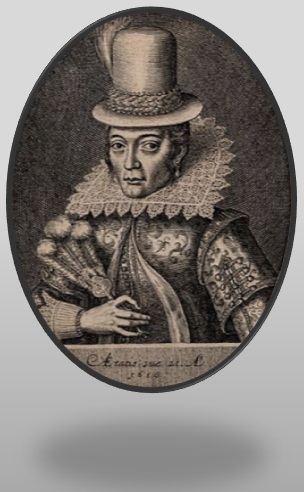
Click the picture for the answer.
Naturalist Photography:
The Immortal Jellyfish
(Turritopsis Dohrnii).

The jellyfish is found in the
Mediterranean and waters off Japan. It is the only known
case of an animal capable of immortality. Like most
hydrozoans, they begin life as tiny swimming larvae called
planula. When a planula attaches itself to the seafloor, a
colony of polyps grows. Jellyfish, also called medusae, bud
off the polyps, and swim off. All the polyps and jellyfish
arising from a single planula are genetically identical
clones.
When a T. Dohrnii jellyfish is exposed to stress, assault,
sickness, or old age, it reverts to the polyp stage, forming
a new polyp colony. Theoretically, this process can go on
indefinitely, effectively rendering the jellyfish
biologically immortal.
Pistol
Shrimp

The shrimp stuns its
prey by snapping a special claw shut. It creates a bubble
that extends out from the claw - reaches speeds of 60 miles
per hour. As the bubble collapses, it reaches temperatures
equal to the surface of the sun! The sound reaches 218
decibels. Imagine a school of this snapping their claws.
Naturalist Illustrations:
Ernst Haeckel (1834 – 1919) was a
German naturalist,
philosopher, physician, and artist. He
discovered and named
thousands of species.
2: To Express Feelings:
Should we only depict good feelings?

Collaborate:
Analyze this untitled poem
E. E.
Cummings (1894-1962):

Two people not in love
by Peter Fuss
Abdi Farah
-
Home
|
3 Bombs

Frida Kahlo and Diego Rivera
Frida Kahlo de Rivera
(1907 – 1954) was a Mexican painter. She
was married to the famous painter and
muralist Diego Rivera.
Her
self-portraits are autobiographical, and
a blend of surrealism, folk art, and
fantasy. Many of her
paintings are an expression of pain.
When she was a child, she contracted
polio, and was disabled. At the age of
eighteen, she was in a traffic accident. Her
injuries caused her severe pain - that
lasted the rest of her life.
View
Kahlo's Art
ABSTRACT
EXPRESSIONISM
JACKSON POLLOCK
video
|
CREATE
Unknown Artist
Marco Grassi
SUSO
Abstract action drawing.
3. To Reveal Metaphysical Truths:
Metaphysics is a branch of philosophy where we ask questions
like: what is real; what is the basic nature of reality;
what is the cause of all things? These are all metaphysical
questions.
In epistemology we ask questions that pertain to knowledge.
These questions can change our view of reality. Does reason alter
belief, or does belief alter reason? In Man's Emerging Mind,
H. J. Berrill said:
| |
I think the statement you often hear that 'seeing is
believing' is one of the most misleading ones a man has ever
made, for you are more likely to see what you believe than
believe what you see. To see anything as it really exists is
about as hard an exercise of mind and eye as it is possible
to perform... .
|
|
Metaphysical, and epistemological, questions have lead philosophers to different visions
of reality - like paintings of Being hanging on some cosmic
wall. The most successful vision of reality belongs to
Democritus (460-360 BCE) and Leucippus. We know it as the
atomic theory of reality; reality consists of atoms moving
in a void. Atoms have properties in themselves like:
position, impenetrability, shape, weight, etc.; they called
these primary qualities. Primary qualities also have the ability to cause
properties in us that are not in the atoms; atoms lack
color, smell, taste, odor, and temperature. Democritus and
Leucippus called secondary qualities. In art the atomic vision is best portrayed by pointillism.
POINTILLISM
Georges Seurat
Keep clicking on the image below.

A
Sunday Afternoon on the Island of la Grande Jatte
|
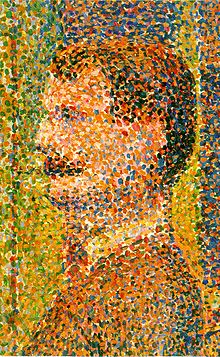
Detail of La Parade
Click the above image twice.
|
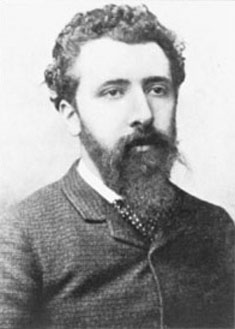
|
SURREALISM
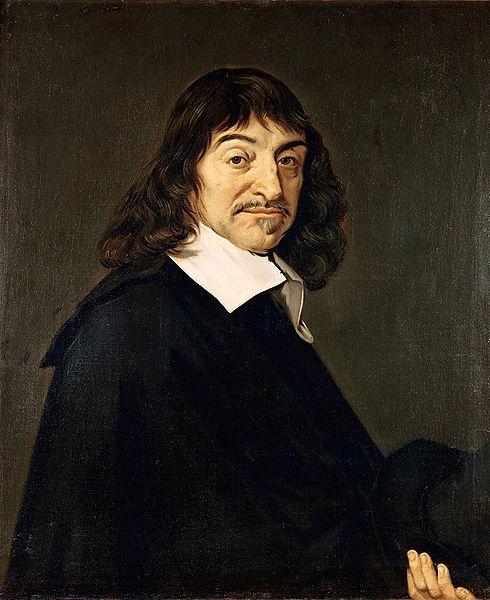
René Descartes
(1596 – 1650) was a French philosopher, and
mathematician. He is considered the father of modern
philosophy. His
Meditations on First Philosophy used a method of doubt
where he attempted to doubt all his beliefs, so he could
find one belief that was impossible to doubt (certain), and
could serve as the foundation to his philosophy - his
starting point. If he seems unreasonable to you, remember
that he wants his starting point to be certain - free of
even the most unreasonable doubt.
How do you know you're
not dreaming? How do you know you're not insane? How do you
know that an evil demon is not attempting to deceive you on
all your beliefs? These questions, although unreasonable to
some extent, lay waste the claim that we know anything for
certain, or do they?
In the second
meditation Descartes said:
| |
"Doubtless,
then, I exist, since I am deceived; and, let him deceive me
[an evil demon]
as he may, he can never bring it about that I am nothing, so
long as I shall be conscious that I am something. ... this proposition ... I am, I
exist, is necessarily true each time it is expressed by me,
or conceived in my mind." |
|
Cogito ergo sum; I think; therefore I exist. Is impossible
to doubt, and is the starting point of modern philosophy,
but this starting point traps us in consciousness. This is
one of the great problems in philosophy. How do we get
outside ourselves to know that our perceptions are accurate
representations of the
real word. It is this problem that surrealism addresses. It
turns to the dream state as it's source of inspiration.
From Le Manifeste du Surréalisme, 1924
ANDRÉ BRETON
Surrealist Animation
Raymond Georges
Yves Tanguy,
1900–1955,
French painter.
Dali and Max Ernst:
Salvador Dali, 1904-1989,
Spanish
Max Ernst, 1891–1976, German painter, sculptor, and poet. He
is a pioneer of the Dada and Surrealist movements.
Rene Magritte,
1898-1967, Belgian Painter
Out of chaos we create form – TED
A Stroke of Insight
4: Different Perspective
DADA Art and Existential Philosophy:
(Art is not a
mirror; it's a hammer.)
The dada
movement began in Zürich Switzerland in 1916 as
a reaction to World War I. They believed that “Destruction
is also creation." Dada can best be defined as art without
rules. It focuses on the absurdity of existence,
irrationality, is countercultural, controversial, and
shocking.
Dadaism looks to existentialist philosophy for inspiration.
Starting with Søren Kierkegaard, the existentialist reacted
against a world at war, and accepted Descartes foundation of
philosophy as consciousness.
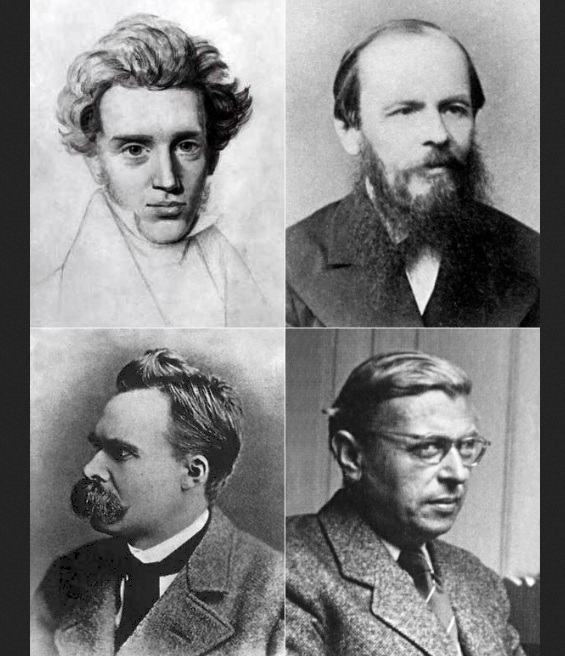
From left to right, top to bottom: Kierkegaard, Dostoyevsky,
Nietzsche, Sartre.
- Science and systematic philosophies are removed from
experience.
- No moral rule can serve as a complete guide.
- Life is meaningless until we define ourselves.
- We are defined by our actions.
- Be true to your nature; be authentic.

Fountain (1917) by Marcel Duchamp
Art is whatever is displayed as art.
Marcel Duchamp (1887
–1968) was a French artist whose work is most often
associated with the Dadaist and Surrealist movements. He
produced relatively few artworks. His output influenced the
development of post-World War I Western art. He advised
modern art collectors, such as Peggy Guggenheim and other
prominent figures, thereby helping to shape the tastes of
Western art during this period.
He said, “The creative
act is not performed by the artist alone; the spectator
brings the work in contact with the external world by
deciphering and interpreting its inner qualifications and
thus adds his contribution to the creative act.”

Collaborate:
Write the Purpose
of art to the left.
FUNCTIONS OF ART :
SOCIAL CHANGE
Dread Scott
Tayler's
What is the Proper Way to Display a US
Flag?
Banksy
www.youtube.com/watch?v=8GVs3BSxoOs
Warning - the above link has material that might be
considered offensive.
Igor Stravinsky -
The Rite of Spring, 1912
Picasso
-
Guernica
- In 1937 the Nazis bombed the
Spanish town of Guernica during the Spanish Civil War. It
was the first aerial bombing of civilians in history.
- 11 feet tall by 25 feet long
– you feel dwarfed by it, and like you’re within the image.
- The painting is done in black, white, and grays to create
contrast.
- The horse dominates the
center, and represents the people.
Watch
Pan’s Labyrinth.
- The
bull symbolizes senseless suffering
(Guernica’s a farming community, and bulls are farm animals.
The bull also represents God - the mother pleads while the bull ignores her.
-
Notice the man holding the flowers.
CRITICISM:

Gabriel Cornelius von
Max, 1840-1915
Monkeys as Judges of Art, 1889
When Picasso was asked what is art, he
responded by saying, "what isn't art?"
Should we censor art?
Since we don’t know all ends, should we tamper with conventions?
Should we glorify
violence and vice? Here is the
Collateral Club Scene with music by Paul Oakenfold
- "Ready Steady go". Notice the repetition in the music.
Without deviation from the norm, progress is not possible."
- Frank Zappa
Guess Who's Coming to Dinner
DECONSTRUCTION
This
theory of art criticism was advanced by the philosopher
Jacques Derrida. He believed that an analysis of any artwork
would yield conflicting meanings. The meaning of a work
arises from the artist and viewer, so there is no absolute
meaning, facts, or truths in art. There are only
interpretations.
FORMAL
CRITICISM
Formal
criticism does not consider any external information. The
work must stand on it's own. This ignores symbolisms that
point to things happening in the world.
read more
Criteria:
Artisanship
Clarity
Coherence
Interest
Is it unique?
CONTEXTUAL CRITICISM
This
includes external factors.
Criteria:
Does the artist
have something to say?
How well does she
say it?
Is it worth saying?
Does it make you
think or feel?
STYLE
Repetition is an element of art.
Repetition in a body of work creates an artist's style.
(1960 - ) is an
American artist. Kostabi World is his New York
studio; it openly employs artists to do all his work. These
artists are grouped as: idea people, image people, and
painting assistants that do all the paintings. Kostai just
signs the artwork.
Amedeo Clemente Modigliani
(1884-1920) was an Italian
artist who worked in France. His unique style is due
to his repetitive distortion of form by elongation. He was addicted to alcohol and narcotics,
and died poor.
Paul Gauguin (7 June 1848 – 8 May 1903)
was a French Primitivism and Post-Impressionist painter. His
style is due to the repetition of his subject matter (people
of Tahiti),
bold colors, simple abstract shapes, exaggerated body
proportions, and stark contrasts. He was influenced by the
art of Africa, and Native Americans.
Georgia O'Keeffe (1887 – 1986) was an American artist
that was inspired by the landscapes of New Mexico, adobe
architecture, and Navajo Indian aesthetic.

